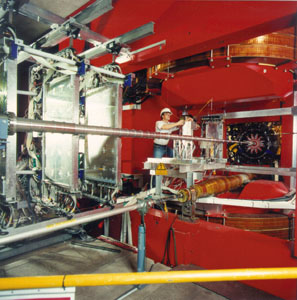
The DESY laboratory in Hamburg has accepted a proposal from the HERA-B experiment for a revised programme of research. This follows the recent commissioning of the B-meson factories at SLAC, Stanford and KEK in Japan, and an earlier recommendation by DESY’s Extended Scientific Council to bring HERA-B to an orderly conclusion in the near future.
The HERA-B experiment was approved in 1995 as a dedicated CP-violation experiment. At the time, the only measurement of this phenomenon, which gives a handle on why nature apparently prefers matter to antimatter, came from experiments on kaon decays at CERN and Fermilab. B-mesons (containing the fifth, beauty or “b” quark) were considered to be richer ground for probing CP-violation, and at DESY a copious source of B-mesons could be provided by a wire target in the halo of the proton beam of the HERA electron-proton collider.
Two “B-factories” were also in preparation in the mid-1990s at SLAC and KEK – each of them single-experiment projects based on novel asymmetric electron-positron colliders. While the B-factories were challenging on the accelerator front, HERA-B was faced with the formidable task of finding its signal amid a background some 12 orders of magnitude as large.
Detecting this signal required a detector of unprecedented radiation hardness that was capable of handling equally unprecedented amounts of data. The ensuing search for radiation-hard technologies has led to important advances in tracking-detector technology, but it has also resulted in substantial delays to the physics programme.
Both B-factories started collecting data in 1999, leading to first results being presented in the summer of 2000. HERA-B, however, had not achieved the required level of sensitivity by the end of HERA’s run in August 2000. In response to the recommendation to conclude the HERA-B programme, the collaboration drew up a two-year plan of alternative research that exploits the unique features of the HERA-B spectrometer and trigger systems, and this was approved in December.
The new programme addresses open questions in strong interaction physics and rare decays of charm quarks. The first results are expected in 2002, when a decision will be taken on continuing, possibly with an enlarged programme to include some of the original goals of the experiment.





